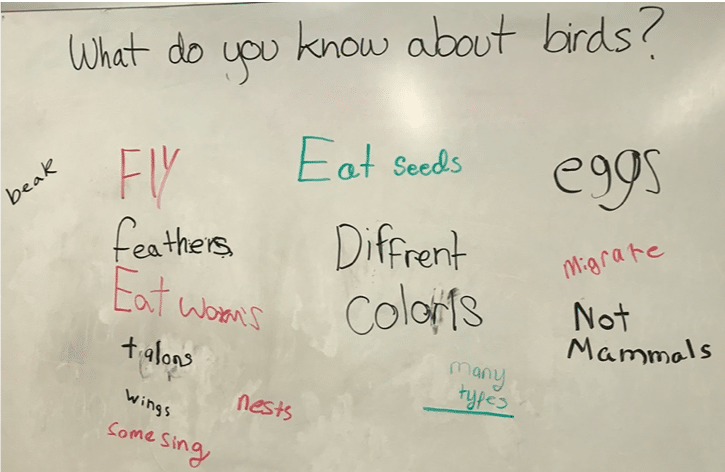Last Updated on October 31, 2024
The connection between listening and reading makes a clear case for using audio stories to promote literacy, and Listenwise brings over 3000 great podcasts to elementary, middle- and high-school classrooms. Below we show you, step by step, how one elementary teacher used an audio story to engage her students in the topic of bird migration.
A Classroom Snapshot
Elementary teacher Gretchen Hummon recently taught the Bird Mystery lesson to her 4th grade class in Leominster, MA. She taught the lesson during her literacy block, highlighting connections to her curriculum in both ELA and science. Grechen used the instructional materials provided, sometimes adapting them to meet her specific goals, and incorporated her regular literacy strategies and routines into the lesson.
Before Listening
To activate prior knowledge, Gretchen opened the lesson by asking students “What do you know about birds?” She called on students and then asked them to write their responses on the whiteboard.

Next, she followed up on a point made by one student and asked “What do you know about bird migration?” prompting students to turn and talk with a neighbor. After they had chatted, she invited them to report their responses to the whole class. She then introduced the podcast “Bird Mystery” and asked students to predict what they thought the story might be about, noting that many reading strategies (such as prediction) also apply to listening. She reminded students that the reading strategy of the week was asking and answering questions, then distributed printed t-chart listening organizers and asked students to jot down their questions as they listened.
During the First Listen
Gretchen then played the audio story for students on her computer. As they listened, students noted their questions on the t-chart, demonstrating their engagement with the story:
- Why does the bird have an antenna?
- Why are birds in trouble?
- How do they know to go to South America and back?
After the First Listen
After they finished listening to the story, Gretchen asked students to turn and talk about each of the listening comprehension questions in sequence. As students shared responses with the class, Gretchen probed, clarified, and asked for elaboration. She invited students to share their own questions and discussed some of those as well. She also introduced vocabulary words from the story that she had listed on a chart.
Sometimes she read the sentence from the podcast transcript to provide context for a word. Other times she asked students to use the word in a sentence of their own. Over the course of the lesson, Gretchen made a mark on the chart each time a word was used, which was a familiar weekly vocabulary routine in her classroom.
During the Second Listen
Next, Gretchen asked students to listen to the podcast again. This time, she directed them to listen for vocabulary words as well as for understanding. She projected the interactive transcript on the screen so students could follow along with highlighted text in sync with the audio.
After the Second Listen
After the class had listened to the podcast a second time, Gretchen asked students to get a Chromebook from the class cart and log into their Google accounts. She had assigned the online quiz accompanying the “Bird Mystery” lesson through Google Classroom. Students logged into their accounts and took the listening comprehension quiz independently.
Finally, Gretchen asked students to write in their writing notebooks about birds, using vocabulary words if possible, and/or to reflect on the podcast lesson.
Once all students had finished the quiz, Gretchen projected the questions on the screen and discussed with students which strategies they used and why they chose the answers they did. This offered the opportunity for students to learn from each other and for their teacher to better understand their thinking to inform further instruction. Reviewing students’ completed listening organizers and writing notebook entries also provided insight into students listening comprehension strengths and weaknesses.
There are many ways to implement each lesson, and this snapshot offers just one example of how Listenwise stories can be integrated into dynamic elementary instruction.
For more ideas on using podcasts in the elementary classroom, see 4 Ways to Integrate Podcasts into Elementary Instruction.
Learn more about elementary podcast lesson sources on Listenwise.
